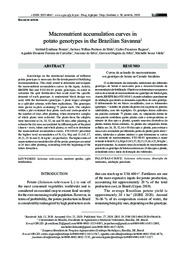Macronutrient accumulation curves in potato genotypes in the Brazilian Savanna.
Macronutrient accumulation curves in potato genotypes in the Brazilian Savanna.
Author(s): PEREIRA, G. E.; MELO, J. W. P. de; RAGASSI, C. F.; CARVALHO, A. D. F. de; SILVA, J. da; SILVA, G. O. da; VILELA, M. S.
Summary: This study aimed to determine and compare the macronutrient accumulation curves in the Agata, Asterix, BRSIPR Bel and F183-08-01 potato genotypes, in order to subsidize the split fertilization that could meet the specific demands of each genotype. A randomized block design was used, with the treatments (genotypes × plant stages) arranged in a split-plot scheme, with three replications. The genotypes were grown in plots containing 75 plants each. The subplots within a plot contained four plants each and corresponded to the number of days after planting, when destructive samples of whole plants were collected. The plants from the subplots were harvested at 24, 38, 52, 66 and 80 days after planting, to estimate the dry mass accumulated by different parts of the plant (shoots + roots, tubers and whole plants), as well as to determine the macronutrient accumulation curves. F183-08-01 presented the highest total accumulation of N, Ca, Mg and S (141.37, 29.21, 25.16 and 22.36 kg ha-1, respectively). The highest rates of macronutrient accumulation for all the potato genotypes occurred at 24 days after planting, coinciding with the beginning of the tubers formation.
Publication year: 2020
Types of publication: Journal article
Unit: Embrapa Vegetables
Keywords: Adubação, Nutrient uptake, Solanum Tuberosum, Split application
Observation
Some of Embrapa's publications are published as ePub files. To read them, use or download one of the following free software options to your computer or mobile device. Android: Google Play Books; IOS: iBooks; Windows and Linux: Calibre.
Access other publications
Access the Agricultural Research Database (BDPA) to consult Embrapa's full library collection and records.
Visit Embrapa Bookstore to purchase books and other publications sold by Embrapa.

